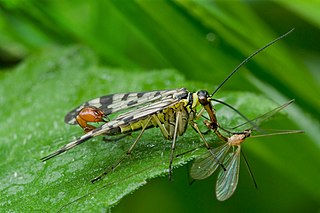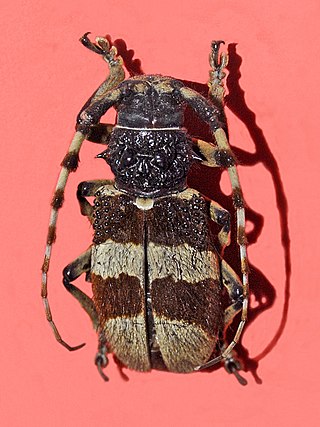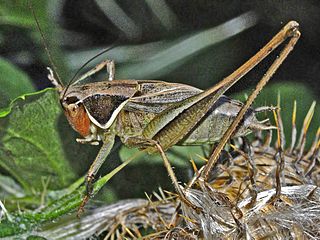
The large red damselfly is a species of damselflies belonging to the family Coenagrionidae. It is native to the western Palearctic.

Portia labiata is a jumping spider found in Sri Lanka, India, southern China, Burma (Myanmar), Malaysia, Singapore, Java, Sumatra and the Philippines. In this medium-sized jumping spider, the front part is orange-brown and the back part is brownish. The conspicuous main eyes provide vision more acute than a cat's during the day and 10 times more acute than a dragonfly's, and this is essential in P. labiata′s navigation, hunting and mating.

Araniella cucurbitina, sometimes called the "cucumber green spider", is a spider of the family Araneidae. Araniella cucurbitina is found across Europe, Western Asia, Central Asia and Japan. The cucurbitina in the name comes from the word cucurbit which is a family of plants including cucumbers.

Goliathus orientalis is a species of beetles belonging to the family Scarabaeidae.
Myrmecia inquilina is a species of ant endemic to Australia in the subfamily Myrmeciinae, first discovered in 1955 and described by Athol Douglas and William Brown Jr. in 1959. These ants are large, measuring 21.4 millimetres (0.84 in). During the time of its discovery, Douglas and Brown announced M. inquilina as the first social parasite among the primitive subfamilies, and today it is one of the two known Myrmecia species to have no worker caste. Two host species are known, Myrmecia nigriceps and Myrmecia vindex. Aggression between M. inquilina and its host species does not occur, and colonies may only produce M. inquilina brood months after the inquiline queens begin to lay their eggs. Queens eat the colony brood or trophic eggs, and other Myrmecia species may kill M. inquilina queens if they reject them. Due to its restricted distribution and threats to its habitat, the ant is "vulnerable" according to the IUCN Red List.

Tettigonia viridissima, the great green bush-cricket, is a large species of bush-cricket belonging to the subfamily Tettigoniinae.

Panorpa communis, the common scorpionfly, is a species of scorpionfly.

Empis tessellata is a species of dance fly, in the fly family Empididae. It is included in the subgenus Euempis.

Dociostaurus maroccanus, commonly known as the Moroccan locust, is a grasshopper in the insect family Acrididae. It is found in northern Africa, southern and eastern Europe and western Asia. It lives a solitary existence but in some years its numbers increase sharply, and it becomes gregarious and congregates to form swarms which can cause devastation in agricultural areas. The species was first described by Carl Peter Thunberg in 1815.

Abispa splendida is a species of wasp in the Vespidae family.

Heterotoma planicornis is a species of bug from Miridae family.

Tenthredo scrophulariae, the figwort sawfly, is a species of the family Tenthredinidae, subfamily Tenthredininae.
Chaco tucumana is a species of mygalomorph spiders of Argentina, named after its type locality: Tucumán. This species differs from C. obscura in the shorter male embolus and the shorter female spermathecal ducts. From other species of the genus it differs in its dark uniform color, the flexible anterior female tarsi, the denser scopulae on the posterior tarsi, and the female spermathecae without a basal protuberance. As in C. obscura, smaller specimens are much lighter in color, and it has darker spots that are evident on the sides of its cephalic region, the apex of femora, base of the patellae and lateral tibiae and dorsal abdomen. Larger specimens are much darker, almost black, with no visible pattern.

Arctolamia fasciata is a species of flat-faced longhorn beetles belonging to the family Cerambycidae.

Chiridopsis punctata is a species of leaf beetles belonging to the family Chrysomelidae.

Sepiana sepium, common name sepia bush-cricket, is a species of bush crickets belonging to the tribe Platycleidini and genus group Platycleis. It is the only species within the monotypic genus Sepiana.

Orestes subcylindricus is a species of stick insects native to Vietnam.

Microrestes robustus is a stick insect species native to northwestern Vietnam.

Haaniella scabra is a species of stick insect native to Borneo and a typical representative of the subfamily Heteropteryginae. The occasionally used common name Small Haaniella refers to the size of this.

Haaniella gintingi is a stick insect species from Sumatra. It is a typical representative of the subfamily Heteropteryginae. The occasionally used common name Ginting’s Haaniella refers to the species name.



















